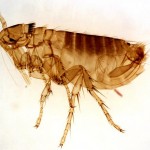Description
Fleas are small insects (under 1/8 inch) and are dark brown in color. They lack wings and are extremely narrow side to side, which enables them to move easily through the hairs of their host. Their last pair of legs is modified for jumping. They have numerous spines and hairs on their body, and their mouth parts are adapted for piercing the skin and sucking blood. The whisker-like spines on and near the head are important characteristics used in the identification of fleas.
Management
Historically, treatment of pets was accomplished in a number of ways. The most common treatment involved the use of shampoos which contained an insecticide. This treatment was effective for only adult fleas that were on the pet when the shampoo was applied and was usually a good way to “clean” a pet prior to transporting them from one location to another (i.e. from a boarding kennel to your home).
- Taken by Kat Masback https://flic.kr/p/6bSYuo
Several types of products are now readily available, which are given orally as a systemic treatment to pets in tablet or capsule form. These products are prescribed by veterinarians and either kill the adults which take a blood meal from the treated animal, or render the fleas unable to reproduce viable offspring hence eliminating future generations. Currently, the most widely used treatment is referred to as a spot-on and involves the application of a small amount of liquid insecticide to the pet between the shoulder blades. This application remains effective for up to a month and will kill adult, biting fleas. These last two options (systemic and spot-on) are perhaps the best choice for most pets and pet owners.
A number of insecticides are labeled for control of fleas in residences. These materials are sprayed onto carpets and into cracks and crevices throughout the building. The benefit of using these materials is that they provide an immediate reduction in the numbers of adult, biting fleas. Unfortunately, most of the effective materials can only be purchased by certified professionals.
Homeowners can have an impact on the numbers of fleas within their homes without the use of pesticides, by thoroughly vacuuming all pet bedding, carpets, floors and upholstered furniture on a daily basis for several weeks. The vacuum cleaner bag should be disposed of after each vacuuming to prevent the adult fleas from crawling out of the cleaner. This is a good method for individuals with known insecticidal sensitivities and allergies and, if used in combination with the systemic and spot-on treatments for pets, will significantly reduce or eliminate flea populations.

